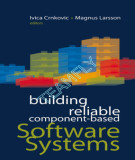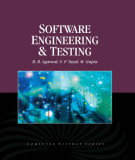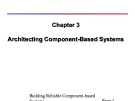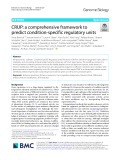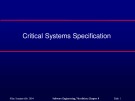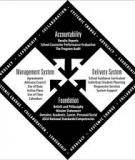
Software reliability specification
-
The book is divided into parts, each of which explores a theme through the different chapters. Each part begins with a short introduction presenting its objective and an overview of the chapters. Although the parts and the chapters are relatively independent of each other, several principles apply to all. The first principle is from general to specific. The book begins with general parts related to software components, proceeds through topics such as processes related to CBSE, continues with domain-specific processes, and concludes with concrete case studies.
 452p
452p  zizaybay1103
zizaybay1103
 29-05-2024
29-05-2024
 2
2
 2
2
 Download
Download
-
Ebook Software engineering and testing an introduction is organized as follows: Chapter 1: introduction to software engineering, chapter 2: software-development life-cycle models, chapter 3: introduction to software requirements specification, chapter 4: software reliability and quality assurance, chapter 5: system design, chapter 6: software measurement and metrics, chapter 7: software testing, chapter 8: software-testing strategies, chapter 9: software maintenance and project management, chapter 10: computer-aided software engineering, chapter 11: coding,…
 529p
529p  zizaybay1103
zizaybay1103
 29-05-2024
29-05-2024
 7
7
 3
3
 Download
Download
-
Ebook Software error detection through testing and analysis is organized as follows: Chapter 1 concepts, notation, and principles; chapter 2 code-based test-case selection methods; chapter 3 specification-based test-case selection methods; chapter 4 software testing roundup; chapter 5 analysis of symbolic traces; chapter 6 static analysis; chapter 7 program instrumentation; appendix A: logico-mathematical background; appendix B: glossary; appendix C: questions for self-assessment.
 271p
271p  zizaybay1103
zizaybay1103
 29-05-2024
29-05-2024
 4
4
 3
3
 Download
Download
-
Lecture Building reliable component-based systems - Chapter 17: Architectural support for reuse. In this chapter, the following content will be discussed: Industrial automation systems, the motivation for a platform, the architecture, developing a domain specific application.
 21p
21p  haojiubujain04
haojiubujain04
 27-07-2023
27-07-2023
 8
8
 4
4
 Download
Download
-
Lecture Building reliable component-based systems - Chapter 2: Specification of software components. This chapter presents the following content: Current component specification techniques, specifying the semantics of components, specifying extra-functional properties of components.
 28p
28p  haojiubujain04
haojiubujain04
 27-07-2023
27-07-2023
 7
7
 4
4
 Download
Download
-
This chapter presents the following content: Introduction, general issues of semantic concern, levels of formalism for semantic specifications, phases in a component’s life, a taxonomy for component semantics.
 18p
18p  haojiubujain04
haojiubujain04
 27-07-2023
27-07-2023
 4
4
 4
4
 Download
Download
-
Lecture Building reliable component-based systems - Chapter 2: Specification of software components. This chapter presents the following content: Current component specification techniques, specifying the semantics of components, specifying extra-functional properties of components.
 30p
30p  haojiubujain04
haojiubujain04
 27-07-2023
27-07-2023
 2
2
 2
2
 Download
Download
-
Lecture Software engineering II: Lesson 30 - Fakhar Lodhi. The main topics covered in this chapter include: statistical software quality assurance, incomplete or erroneous specifications (IES), misinterpretation of customer communication (MCC), error index (EI), software reliability,...
 13p
13p  youzhangjing_1909
youzhangjing_1909
 28-04-2022
28-04-2022
 8
8
 1
1
 Download
Download
-
We present the software Condition-specific Regulatory Units Prediction (CRUP) to infer from epigenetic marks a list of regulatory units consisting of dynamically changing enhancers with their target genes. The workflow consists of a novel pre-trained enhancer predictor that can be reliably applied across cell types and species, solely based on histone modification ChIP-seq data.
 23p
23p  vielonmusk
vielonmusk
 30-01-2022
30-01-2022
 12
12
 0
0
 Download
Download
-
Lecture Software Engineering - Chapter 9: Critical Systems Specification, objectives: To explain how dependability requirements may be identified by analysing the risks faced by critical systems; To explain how safety requirements are generated from the system risk analysis; To explain the derivation of security requirements; To describe metrics used for reliability specification.
 50p
50p  tomjerry005
tomjerry005
 17-11-2021
17-11-2021
 4
4
 0
0
 Download
Download
-
Formal methods mathematical languages, techniques and tools, used to specify and verify systems, goal is help engineers construct more reliable systems. Introduction to Formal Methodspresents about introduction; formal specification; formalformal verificationverification; model checking; theorem proving.
 29p
29p  ngkhacvu
ngkhacvu
 22-05-2015
22-05-2015
 66
66
 6
6
 Download
Download
-
This five-step guide details the recommended process for building software-defined test systems from start to finish. It presents these test engineering best practices in a practical and reusable manner and features specific examples used by industry-leading test engineering teams. It also references a scalable, software-defined production test system developed by the NI test engineering team for testing I/O modules for the NI CompactRIO platform, which is shown in Figure 3.
 101p
101p  hoangphiyeah1tv
hoangphiyeah1tv
 24-04-2013
24-04-2013
 58
58
 3
3
 Download
Download
-
Internal audit technologies can greatly improve the efficiency, quality and consistency of the audit process. Data analysis software can also enhance the audit by allowing the computerised testing of entire populations of data as opposed to relying on detail testing of sample data. Internal audit infrastructure and methodologies can be developed internally or acquired from a third party. PricewaterhouseCoopers, for example, offers the TeamMate™, an integrated electronic working paper software application designed specifically for internal auditors.
 11p
11p  doipassword
doipassword
 01-02-2013
01-02-2013
 48
48
 2
2
 Download
Download
-
Component-based development (CBD) is an extension of object-oriented programming. CBD does away with the language and vendor-specific limitations of OOP, makes software reuse more practical and accelerates the development process. Event-based programming is the next logical step in CBD, and makes components more reusable due to their decoupled nature. But event-based systems are easier to develop, which means they’re cheaper and more reliable than traditional OOP or CBD systems.
 671p
671p  hoa_can
hoa_can
 29-01-2013
29-01-2013
 46
46
 5
5
 Download
Download
CHỦ ĐỀ BẠN MUỐN TÌM








